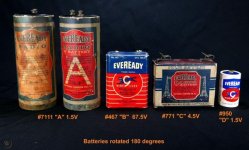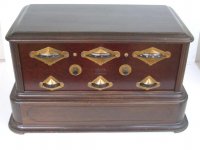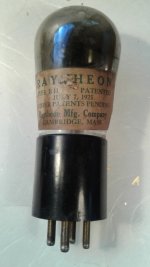I now have a Hammond 1140-LN-C hooked up as the step-up transformer on the input. More detail and more high treble than the 124B. Not as smooth - it's a trifle bright but that may be elsewhere in the system possibly, and the 124B is a bit down around 15K. At present it's terminated with 100K but this may be wrong, I'll have to experiment and ask Hammond. The transformers are heavy and well-made with solid fixing lugs and wire terminations. I'll swap between them for a while.
I built a 46 stage as well as the 2P29L and 10Y stages, which are both in filament bias. The 46 isn't at present but I'm going to convert it to filament bias and see if the sound improves. That was the case with the 10Y and 2P29L. I'm pretty sure the 46 is my favourite DHT, even against the 10Y.
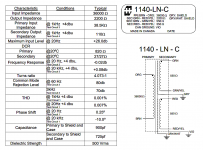
I built a 46 stage as well as the 2P29L and 10Y stages, which are both in filament bias. The 46 isn't at present but I'm going to convert it to filament bias and see if the sound improves. That was the case with the 10Y and 2P29L. I'm pretty sure the 46 is my favourite DHT, even against the 10Y.

Beautiful amplifiers. Was there a technical reason for using the Ray of God rectifier?OK - so, not all triodes but all direct heated ... the circuit is 6A4/LA as triode driving 6A4/LA in ultralinear single-ended. Delivers 1 Watt @ 5% THD to 10" full-range drivers.
Not shown in the schematic:
This started life as 6A4/LA triode driving a type 52 in Class A2, an amplifier I dubbed the Octogenarian since every valve was at least 80 years old (the BH was over 90). But that amp didn't sound sound good above about 0.25W so I converted the output stage to 6A4/LA SEUL (still Octogenarian 🙂 ). It still needs tweaking (so many projects, so little time .... ) to improve the output stage and improve the snubbing of the HT transformer.
- Coleman 6.3V filament regs, or the power transformers, rectifiers and filters feeding them; and
- the HT power supply, in which I used a type BH cold cathode rectifier and C-L-C-R-C filtering (shown on the breadboard).
A better way is to use tube rectifiers. No snubbing necessary.No better way to snuber the power transformers that using Quasimodo and scope.
Built in RF Generator for the lab? 😀Was there a technical reason for using the Ray of God rectifie
Attachments
No technical reason - I simply wanted to build with some of the the oldest valves in my stash. 🙂Beautiful amplifiers. Was there a technical reason for using the Ray of God rectifier?
As for snubbing, I use Mark Johnson's lovely "Quasimodo" rig and find that it improves the waveform in every rectifier circuit I have built, including those using valve rectifiers. However, I didn't snub the BH rectifier circuit and I need to fix that!
As for RF from cold cathode rectifiers, I have found it variable. I have one BH that is noisy, and another 0Z4A - bursts of RF show in the ripple displayed by the Tektronix TDS360 'scope. The rest seem well-behaved.
Sure was! To put it into historical context, until Raytheon's B, BH, BA and BR rectifiers became available from 1925, radio owners faced the recurring expense of replacing high tension batteries ("B" cells) and filament batteries ("A" cells). The pictures show a typical Eveready radio battery line-up, and a 1925 Grebe Synchrophase radio receiver sitting on top of its very elegant battery box.Wow! That was a lot of (expensive) filtering in those days.
For those radio owners that that could afford the up-front- cost, Raytheon's cold-cathode rectifiers were very attractive (no more buying batteries) and Raytheon encouraged radio designers to shift away from batteries. Raytheon made a LOT of money and managed to avoid bankruptcy.
Attachments
Yes, electrolytic capacitors were not invented yet, and low DCR requirement for a 30 H choke would be difficult to meet. But PSU design principles laid out in the article are still valid today. There is a lot of importance assigned to output voltage regulation. The zero impedance of the rectifier prompts a designer to reduce to a practically possible extent the DCRs of power transformer and choke, so that amplifier transients draw available current directly from the supply, rather than from filter capacitors. This is the principle I am striving to follow in my power supplies - overrrated power transformer, low voltage drop rectifiers, low DCR chokes, multi-stage filter, low value high quality filter capacitors.Wow! That was a lot of (expensive) filtering in those days.
Great work, thank you! I’ll be waiting for your impressions on this new SUTI now have a Hammond 1140-LN-C hooked up as the step-up transformer on the input. More detail and more high treble than the 124B. Not as smooth - it's a trifle bright but that may be elsewhere in the system possibly, and the 124B is a bit down around 15K. At present it's terminated with 100K but this may be wrong, I'll have to experiment and ask Hammond. The transformers are heavy and well-made with solid fixing lugs and wire terminations. I'll swap between them for a while.
I built a 46 stage as well as the 2P29L and 10Y stages, which are both in filament bias. The 46 isn't at present but I'm going to convert it to filament bias and see if the sound improves. That was the case with the 10Y and 2P29L. I'm pretty sure the 46 is my favourite DHT, even against the 10Y.
View attachment 1093528
It's good - happy with the Hammond 1140-LN-C. Detailed with good tone. Very economical too. A quality product. I'm ordering some more.Great work, thank you! I’ll be waiting for your impressions on this new SUT
I'm now using a 46 tube as input to my 2a3. Love this tube. Pretty unobtanium in Europe, but you can still buy some in the USA.
Did you keep the same resistor value across the secondary? In fact I guess you used the secondary as the input winding, am I wrong? Please let us know if you get any feedback from Hammond. Among the two Hammond's, I understand you prefer the 1140-LN-C, do you?
I recently bought some CX301-A which I would like to use in an all DHT amp. Do you have any experience with this triode?
Many thanks!
I recently bought some CX301-A which I would like to use in an all DHT amp. Do you have any experience with this triode?
Many thanks!
Last edited:
The 100K was just the grid resistor which was on the input, but it sounds better when you remove it and leave the SUT unterminated which is what I've done. The 1140-LN-C is the one to buy. I ordered 2 more pairs.Did you keep the same resistor value across the secondary? In fact I guess you used the secondary as the input winding, am I wrong? Please let us know if you get any feedback from Hammond. Among the two Hammond's, I understand you prefer the 1140-LN-C, do you?
I recently bought some CX301-A which I would like to use in an all DHT amp. Do you have any experience with this triode?
The 01A is a nice tube but I don't use it as a driver. You need at least 10V bias if you use a 1:4 SUT, and more would be even better. With the 01A this reduces you to 3 or 4 mA current which isn't much. Just not a good operating point. The 112A would be more suitable. So would a 2P29L in triode or 26. Or my favourites, 10Y and 46. I currently use the 10Y in filament bias and I'm about to convert the 46 to filament bias. Much easier to get 10V or more bias with these tubes.
I use resistor loads because I like a pure tonality. The 01A has been used with Ale Moglia's active load and follower arrangement which converts it to a driver tube, and that has a fan base. You could look at that. But for my tastes a different valve as above would work better.
Andy - I am following your progress with much interest. Good to know your success with your new Hammond input transformer.
I agree that 01A won't fly as driver without step-up interstage transformer. Limited plate voltage would not allow stepping up the input with this tube.
10 is a different story. With its high plate voltage and substantial current, it can be used as driver with input SUT in a two-stage 2A3 amplifier.
46 isn't so. Not as high maximum plate voltage as 10 would not allow input SUT with step ratio higher than 1:3. Low amplification factor of 46 rules out two-stage design.
Why not using plate choke in driver stage? You advocated plate choke previously, but now seem to prefer resistor load. Any reason for changing your preference?
I agree that 01A won't fly as driver without step-up interstage transformer. Limited plate voltage would not allow stepping up the input with this tube.
10 is a different story. With its high plate voltage and substantial current, it can be used as driver with input SUT in a two-stage 2A3 amplifier.
46 isn't so. Not as high maximum plate voltage as 10 would not allow input SUT with step ratio higher than 1:3. Low amplification factor of 46 rules out two-stage design.
Why not using plate choke in driver stage? You advocated plate choke previously, but now seem to prefer resistor load. Any reason for changing your preference?
The 46 is just fine. Sounding marvellous with 1:4 step-up. Mu is 5.6, it's true, but I don't listen loud. The 10Y does have more gain like you say. Mu of 8. The 2P29L has the most gain at 9. I haven't tried the 112A yet, mu 8.5, but I will. I have box-fulls of DHTs.10 is a different story. With its high plate voltage and substantial current, it can be used as driver with input SUT in a two-stage 2A3 amplifier.
46 isn't so. Not as high maximum plate voltage as 10 would not allow input SUT with step ratio higher than 1:3. Low amplification factor of 46 rules out two-stage design.
Why not using plate choke in driver stage? You advocated plate choke previously, but now seem to prefer resistor load. Any reason for changing your preference?
I could use a plate choke, it's true, and I have some amorphous ones even. I may try those at some point. I just like the tonal purity of resistor loads. Plate chokes would mean higher voltages and more current of course, better operating points.
Latest build is a 112A. I would say this is superior to the 2P29L. It has much better tonality for a start - the tonal quality of acoustic instruments is really very good. It's also a more full sound - more body and better bass. So high marks for tone.
The only thing it loses out on compared to 46 and 10Y and indeed 01A is a bit of extra sparkle and presence. It's a neutral and natural sound. I'm going to experiment with the caps in the power supply to see what that does. The bias is -9v so I'll also try the 01A at book value of 135V, -9V and 3mA. That's not much current, though.
The only thing it loses out on compared to 46 and 10Y and indeed 01A is a bit of extra sparkle and presence. It's a neutral and natural sound. I'm going to experiment with the caps in the power supply to see what that does. The bias is -9v so I'll also try the 01A at book value of 135V, -9V and 3mA. That's not much current, though.
AndyLatest build is a 112A. I would say this is superior to the 2P29L. It has much better tonality for a start - the tonal quality of acoustic instruments is really very good. It's also a more full sound - more body and better bass. So high marks for tone.
The only thing it loses out on compared to 46 and 10Y and indeed 01A is a bit of extra sparkle and presence. It's a neutral and natural sound. I'm going to experiment with the caps in the power supply to see what that does. The bias is -9v so I'll also try the 01A at book value of 135V, -9V and 3mA. That's not much current, though.
What's your latest schematic please?
Ha! I said I was going to experiment with the power supply caps and that turned out to be more important than I realised. The 2P29L stage had a standard Dubilier 22uF as first cap and the 112A had a 15uF Kemet DC Link cap. I swapped around these caps in both stages, and it turns out that some of the tone quality is coming from the first cap. When I put a DC Link cap in first position in the 2P29L stage the sound improved quite audibly - the tone was fuller with a perceptibly better timbre to instruments and voices. For those that are sceptical about capacitors in the power supply, you don't need to consider this. But I assure those who do believe that caps make a difference that I'm calling this just as I hear it - the tonality with the DC Link cap is a step up. I wouldn't put the electrolytic back. Who knows if there are better caps again. I'm happy I made this discovery since it's quite audibly an improvement. I also use a DC Link cap as last cap in the PSU chain in all my builds. I'm OK with an electrolytic as the middle cap. Schematics I used for the 112A and 2P29L builds below.
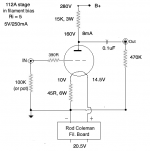
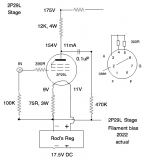


- Home
- Amplifiers
- Tubes / Valves
- All-DHT amplifiers: no indirectly heated signal tubes!
